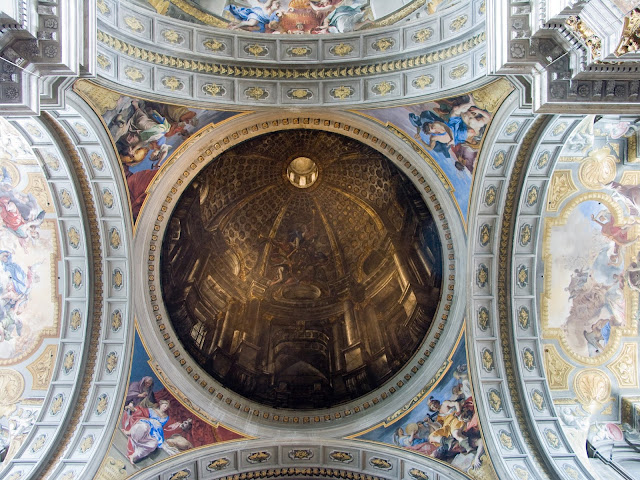The great church of San Ignazio in Rome is a Jesuit church designed and built by Jesuits for other Jesuits. Pope Francis is a Jesuit, a member of the Society of Jesus, the largest and most famous of the preaching orders that came out of the Catholic Counter-Reformation of the 16th century. The Jesuits built the church to mark the canonization of their founder St. Ignatius Loyola in 1622. They built it attached to the College of Rome that later in the 17th century moved to a new location and became the Gregorian University in Rome.
A Jesuit professor of mathematics at the College of Rome Orazio Grassi designed the church with some consultations from Carlo Maderno who was invited to submit proposals for the church.
Like Giacomo Vignola's Il Gesu, the mother church of the Jesuit order across town, Sant' Ignazio is a big hall church built for preaching. An enormous uninterrupted hall space forms the bulk of the church with chapels on the side. A three bay nave terminates in a crossing with an apse that is as high and wide as the nave, very much like an earlier prototype for these Counter-Reformation preaching churches, Sant' Andrea in Mantua built at the end of the 15th century. Both Sant' Andrea and Sant' Ignazio were designed to accommodate very large crowds, giving them clear views of the altars and pulpits.
Today Sant' Ignazio is most famous for the contribution of another Jesuit, a lay brother named Andrea Pozzo who painted the spectacular fresco cycle in the church, the last great painted spectacle in Baroque Rome. He spent nine years from 1685 to 1694 working on the ceiling, apse, and a tromp l'oeil dome.
The nave ceiling painting, The Apotheosis of St. Ignatius Loyola is a masterwork of quadratura illusionism that uses architecture and perspective that influenced similar ceiling painting projects all over Europe into the 19th century.
When viewed from a spot in the floor of the nave marked by a marble circle below, the illusion of the painting comes together.
Viewed from that spot, it's hard to tell where the nave vault ends and the painting begins. It looks as if the ceiling opens up into the wider sky with figures floating upward like bubbles in seltzer.
It's an undeniably spectacular and irresistible effect. The painting is supposed to be a complex allegory of the global mission of the Jesuit order, but all that is lost in the dazzling theatrical spectacle set out before us on the ceiling.
Saint Ignatius Loyola received into heaven in the dramatic center of the painting. Four rays of light emanate from him to the four allegorized continents of the earth (as known at the time, Australia and Antarctica appear on maps much later than this painting). Down on the lower right I presume is St. Francis Xavier sent by St. Ignatius to India.
This detail spells out a major theme of the painting, a passage from St. Luke's Gospel that meant a lot to Jesuit missionaries, "I have come to set the world on fire."
St. Francis Xavier looks down at the large woman on the lower right edge who stands for Asia.
The Name of Jesus carried by an angel.
The continent of Europe.
Africa rides a crocodile
A very beautiful detail. Pozzo may not have been a great painter, but he was a very good one.
Asia riding a camel with St. Francis Xavier looking down at her.
Another fine detail.
The whole painting on the nave ceiling once again.
The apse and high altar with paintings by Andrea Pozzo.
In the half-dome of the apse, St. Ignatius appears in glory to the people of Rome. Below is a cartouche with the words spoken by Christ to St. Ignatius appear in Latin: Ergo Vobis Propitius Ero (I will be favorable to you [at Rome]).
Above the high altar is St. Ignatius' Vision in the Chapel of La Storta that began his religious calling.
St. Ignatius sends St. Francis Xavier to India
St. Ignatius receives Francesco Borgia who will become the first "general" of the Jesuit order.
Andrea Pozzo's painted spectacles in Sant' Ignazio were art for the masses. They thrilled religious pilgrims, the Roman public, and Jesuit seminarians just as much as they thrill tourists today, and that was the point. These kinds of spectacles were not the least bit interested in reflecting real life back to their audiences. They were about making the stories and doctrines of the Roman Catholic Church as vividly real as possible, so real they seem to fly over our heads. The illusionism stretches the boundary between art and reality without quite breaking it.
Writers describe Baroque art as "theatrical" all the time and rightly so, but it's a specific kind of theater, machine theater, the theater of special effects. Hollywood uses the same concepts when producing summer blockbuster movies. The point is not to reflect real life back at their audience, but to make their worlds of fantasy and story so vivid that they seem to fly out of the screen and into the theater.
Respectable critics and academics have frowned on this kind of art for over two centuries, and still do. The idea that simple paint on a wall or ceiling could produce something so vivid and appealing so immediately and so broadly thrills the imagination of this painter.
Andrea Pozzo's proud self portrait
The beautiful Rococo Piazza San Ignacio in front of the church.
Note: All of these photos come from Wikimedia Commons.


























No comments:
Post a Comment